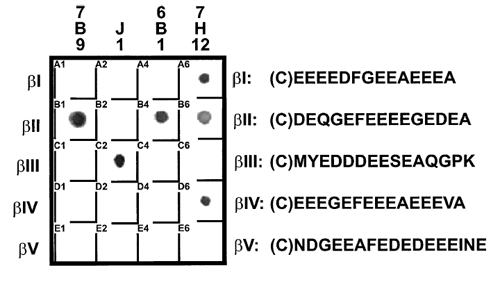Beta Tubulin Type II [7B9] Antibody
This IgG mouse antibody was generated against the C-terminus of beta II tubulin (CEEEEGEDEA) and recognizes mammalian homologs.
Microtubules are required for many well characterized functions in eukaryotic cells, including the movement of chromosomes in mitosis and meiosis, intracellular transport, establishment and maintenance of cellular morphology, cell growth, cell migration and morphogenesis in multicellular organisms. The building block of a microtubule is the tubulin subunit, a heterodimer of alpha and beta tubulin. Both of these monomers are found in all eukaryotes, and their sequences are highly conserved. The tubulin protein is a major target of drug molecules, and consequently, tubulin inhibitors have attracted great attention as antimitotic antitumor agents for chemotherapeutic use.
Class II beta tubulin is the major form of tubulin beta in neurons, although it is not neuronal specific. It is found in many other tissues including lung tissue and Schwann cells. It binds two moles of GTP, one at an exchangeable site on the beta chain and one at a nonexchangeable site on the alpha chain.
From the laboratories of Anthony Frankfurter, PhD and Anthony Spano, PhD, University of Virginia.
This IgG mouse antibody was generated against the C-terminus of beta II tubulin (CEEEEGEDEA) and recognizes mammalian homologs.
Microtubules are required for many well characterized functions in eukaryotic cells, including the movement of chromosomes in mitosis and meiosis, intracellular transport, establishment and maintenance of cellular morphology, cell growth, cell migration and morphogenesis in multicellular organisms. The building block of a microtubule is the tubulin subunit, a heterodimer of alpha and beta tubulin. Both of these monomers are found in all eukaryotes, and their sequences are highly conserved. The tubulin protein is a major target of drug molecules, and consequently, tubulin inhibitors have attracted great attention as antimitotic antitumor agents for chemotherapeutic use.
Class II beta tubulin is the major form of tubulin beta in neurons, although it is not neuronal specific. It is found in many other tissues including lung tissue and Schwann cells. It binds two moles of GTP, one at an exchangeable site on the beta chain and one at a nonexchangeable site on the alpha chain.
From the laboratories of Anthony Frankfurter, PhD and Anthony Spano, PhD, University of Virginia.
| Product Type: | Antibody |
| Accession ID: | Q13885 |
| Isotype: | IgG |
| Clonality: | Monoclonal |
| Clone Name: | 7B9 |
| Specificity: | Class II Beta Tubulin (all mammalian homologs) |
| Immunogen: | Generated against C-terminus of Class II Beta Tubulin (CEEEEGEDEA) |
| Species Immunized: | Mouse |
| Purification Method: | Protein A/G Chromatography |
| Tested Applications: | WB, IF, IP |
| Storage: | -20C |
| Shipped: | Cold packs |

Dot blot of b-tubulin peptides and isotype-specific monoclonal antibodies. Tubulin carboxyl-terminal peptides were transferred to PVDF and reacted with isotype-specific monoclonal antibodies. Equal quantities of peptide sequences shown (right) were applied to the blot.
Adapted from: Lobert S, Frankfurter A, Correa JJ. Energetics of vinca alkaloid interactions with tubulin isotypes: implications for drug efficacy and toxicity. Methods Cell Motil Cytoskeleton. 39(2):107-121, (1998).
- Moody SA, Miller V, Spanos A, Frankfurter A. Developmental expression of a neuron-specific beta-tubulinn in frog (Xenopus laevis): a marker fro growing axons during the empryonic period. J Comp Neurol. 8;364(2):219-230, (1996).
If you publish research with this product, please let us know so we can cite your paper.

![Beta Tubulin Type II [7B9] Antibody Anti-GFP (Chicken-Standard) Antibody](https://www.kerafast.com/MediaStorage/Product/Images/Medium/113_200120200125541120D.jpg)
